Buddhist Fables
- The Story of Ruru Deer
- The Story of Two Swans
- The Hare on The Moon
- The Story of Chaddanta Elephant
- The Story of Great Monkey
- The Story of The Two Deer
- The Story of a Buffalo
- Silava Elephant
- The Wise Monkey
- The Story of the Golden Swan
- The Story of The Great Ape
- The Mighty Fish
- Story of the Monkey King
- Lion and Jackal
- Somdatta
- The Story of the Crows
- The Monkey Brothers
- The Story of Nigrodha Deer
- Kalbahu
- Nandivisala
- Coronation of Owl
- The Feast of the Dead
- The Heart of the Monkey
- The Story of a Rooster
- The Story of a Tigeress
- The Pigeon and The Crow
- The Story of Romaka Pigeon
- The Story of Khardiya Deer
- The Thankless Monkey
- Can A Fool Ever Act Good!
- The Story of a Tortoise
- Jackal –The Arbitrator
- The Story of a Snake Charmer
- The Leather Garment
- The Giant Crab
- Mahilaimukha Elephant
- The Story of Vinilaka
Buddhist Classics
- The Sacrifice of Vessantara
- The Wisdom of Vidhura Pandita
- Chullabodhi – The Conqueror of Anger
- The Story of Kushinagar
- The Virtue of Forbearance
- Matanga – The World’s First Crusader of Untouchability
- The Temptation of Isisanga
- The Flight of Sakka
- Mahajanaka’s Renunciation
- The Wine-Jar
- The Sacrifice of Sivi
- The Box of the Monster
- The Lotus Stalk
- Kandari – The Handsome Prince
- Ghat: The Virtuous King
- Supparaka – The Ancient Mariner
- Sankhapala: The Naga King
- Champeyya
- The Baveru Island
- The Great Gambler
- The Story of The Dumb Prince
- The Naive House-Holder
- The Jewelled Serpent
- The Mango-Thief
- The Foot-Print Reader
- The Story of Sutasoma
- The Story of Sudasa
- The Little Bowman
- The Envoy of Belly
- Story of a Drummer
- The King, Who Knew The Language Of Animals
- The Happy Man
- Sama: The Good Son
Life and Legends of Buddha
- Gotama Buddha
- Birth Story of Gotama
- Maha Maya’s Dream
- Sage Asita’s Visit
- The Four Sights
- Story of Renunciation
- The Buddha’s Victory over Mara
- The Personality of the Buddha
- Nalgiri Elephant
- Story of Kumara Kassapa
- Dhamma-Chakka-Pavattana-Katha
- The Buddha’s Teaching of Abhidhamma
- Buddha's Visit to Rahula Mata
- The Savatthi Miracles
- The Flying Buddha
- Story of Parinibbana
- Suddhodana
- Sujata
- Sariputta
- Moggallana
- Story of Mara
- Bimbisara
- Nanda
- Janapada Kalyani Nanda
- The Spiritual Journey of Janapada Kalyani
- Phussa Buddha
- Vipassi Buddha
- Sikhi Buddha
- Vessabhu Buddha
- Kakusandha Buddha
- Konagamana Buddha
- Kassapa Buddha
- Metteya
The Illustrated Jataka & Other Stories of the Buddha by C. B. Varma Introduction | Glossary | Bibliography
INTRODUCTION
- The Number of the Jataka Stories
- Concept of the Buddha and Bodhisatta
- Common Facts about the Buddha
- Bodhisatta (Pali Tradition)
- Various Births of the Bodhisatta
- Treatment of the Pali Jataka Stories
- Jatakas in the Sanskrit Language
- Buddha & Bodhisattva (the Mahayana View)
- Mudras of each of the Dhyani Buddha
Available originally in verses the Jataka Stories or the collection of the stories of the previous births of Sakyamuni Buddha, (563 BC-483 BC) is the tenth book of the Khuddaka-Nikaya, which in turn is a part if the corpus of the Sutta-Pitaka belonging to the Buddhist canon.
The Buddhist canons are classified into three pitakas or collections, which literally, mean “baskets”. Traditionally, these pitakas were first compiled in the first Buddhist council held in Rajgir, after the parinibbana (or the demise) of Gotama Buddha (483 B.C) during the reign of Ajatasattu (Sanskritised: Ajatashatru), the king of Magadha. The other two Buddhist canons are the Vinaya-Pitaka and the Abhidhamma-Pitaka.[i]
Many scholars believe that the Tipitaka was compiled in the third Buddhist council. But such claims appear to be fragile when we turn to the Mahavamsa (one of the most reliable sources of the Buddhist history),[ii] as it is explicitly stated that the convention of the third Buddhist council, which took place in Pataliputta (Sanskritised Pataliputra; modern Patna during the reign of the Emperor Asoka) one thousand erudite monks “well versed in the Tipitaka …”[iii] were chosen for the re-compilation of the original and purest teachings of the Buddha to purge the interpolations crept therein in the original corpuses. The above statement is assertive of the fact that the Tipitaka definitely existed before the third council. Its form might have been somewhat different from the text compiled in the third council; or ever since it was put to writing in Sri Lanka since 80 BCE. (See Anil Goonewardene, The Schools and Traditions of Buddhism (in Outline) and their Common Features. Buddhist Society London: 1991; p.1).
The Jataka legends occur in the Vinaya Pitaka, too. For example, the Jataka (No.10); Tittira Jataka (No.37) are to be found in the Chulla-Vagga (vii.1; and vi.6, respectively). Further, the Chariya-Pitaka, a book of the Sutta-Pitaka, contains thirty-five Jatakas in verse-form. Besides, several Jatakas exist in the canonical texts but not included in the Jataka collection. Further, the Samantapasadika makes a reference to the Jataka Nikaya; and the Dighabhanakas, i.e., those who recited the Suttas or discourses of the Digha Nikaya included the Jataka in the Abhidhamma Pitaka.
Classified into twenty-two sections (or nipatas) the Jataka of the Khuddaka Nikaya is traditionally believed to follow the scheme of classification by way of the number of the verses included in a section. However, this statement is not to be taken to be literally true. For example, Section One (Eka-Nipata) is supposed to contain the stories by way of the explanation of one single verse; and thus the number increases in ascending order in the following sections. Unfortunately, no such perfect anthology is available today to exemplify the traditionally acknowledged scheme.
The most systematic anthology of the Jataka stories, called the Jataka Atthakathas, as is handed down to us by the tradition, is ascribed to Buddhaghosa of Nalanda. The author translated those texts from Singhalese by visiting Sri Lanka, as he could not find any reliable version extant in India. These texts were, however, written and preserved in Sri Lanka. (Later, the original Singhalese version of the texts, too, is declared “lost”).
Nonetheless, the popularity of the Jataka stories in India was no less consequential, as the Jataka scenes have been the favourite themes in the sculptured carvings on the railings in the relic shrines of Sanchi, Amaravati and Bharhut, Nagarjunakonda and Goli. Some of which may well be dated back to the third century B.C. The scenes from the Nigrodha-miga-Jataka (No.12), Hamsa Jataka (No.32), and Makhadeva-Jataka (No.9) shown in the Bharhut Plate No.XXV, figure 1; No.XXVII figure 11; and No.XLVIII figure 2, respectively in Cunningham’s The Stupas of Bharhut can further corroborate to the above fact.
These stories have been “remarkably popular” in Europe, too, as E.B.Cowell in the Preface to the Jataka Stories observes:
The same stories may thus in course of their long wanderings, come to be recognised under widely different aspects, as when they are used by Boccaccio or Poggio merely as merry tales, or by some Welsh bard to embellish king Arthur’s legendary glories, or by some Buddhist samana or by some medieval friar to add point to his discourse. Chaucer unwittingly puts a Jataka story into the mouth of his Pardonere when he tells his tale of ‘the ryotoures three’; and another appears in Herodotus as the popular explanation of the sudden rise of Almaeonidae through Megacles’ marriage with Cleisthenes’ daughter and the rejection of his rival Hippocleides.
(The Jataka, Cambridge University Press: 1895 p. ix)
The stories of the Buddha and the Bodhisattas at one stage were extremely popular in Indonesia as well as is exemplified in the first 135 sculptures of Balushade (top series) in the first gallery of Borobudur temple in Java are based on the stories of the Jatakas. (See N.J.Krom, Borobudur v.1 and plates series I.B.xiii). Besides, the countries like Thailand, Myanmar and Sri Lanka still have a living tradition of narrating the stories of the Buddha by way of mural and other paintings in the monasteries. But it is unfortunate to recall the destruction of myriad paintings or pictorial stories in the sculpted niches in Afghanistan, particularly in Bamiyan. Some of these paintings and like remnants are now being preserved in Switzerland in a proposed museum. But such losses are irretrievable in the history of human civilisations.
The Number of the Jataka Stories
To determine the actual number of the Jatakas is, however, a matter of controversy. According to the Niddesa, a book of the Khuddakanikaya (generally, ascribed to Sariputta and Mahakacchana) the total number of the Jatakas is 500. The memoirs of Fah-hian (Faxian), the famous Chinese traveler – who visited Abhayagiri in Sri Lanka and recorded 500 representations of Bodhisatta in successive births – also confirm the above view. The Saketa-Jataka (No.68) states that Sakyamuni Buddha had 1500 births. The Fausboll’s edition contains 547 Jatakas; or the Jataka tales.
Concept of the Buddha and Bodhisatta
As the Jatakas delineate a kaleidoscopic view of the journey of the Bodhisatta (Sanskrit Bodhisattva) undergoing several stages of birth or junctions to become a Buddha the acquaintance with the concepts of the ‘Buddha’ and the ‘Bodhisatta’ is of great relevance. Thus in the above context a brief exposition of the meaning and purport of the two aforementioned terms – ‘the Buddha’ and ‘the Bodhisatta’ – is being made below.
The Buddha
The Buddha is a generic and appelative name, which must not be confused with one proper name though it commonly refers to Sakyamuni Gotama Buddha (543–483 B.C.).
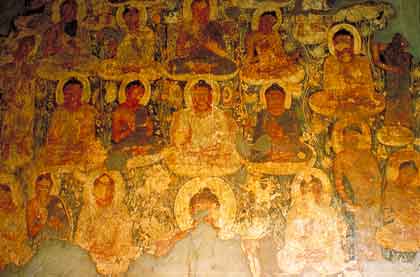
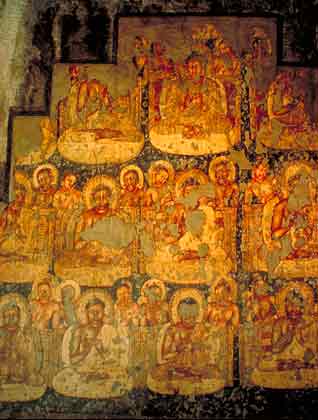

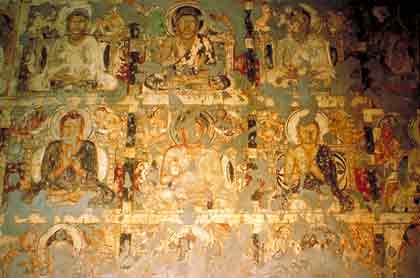
Various Buddhas, Ajanta
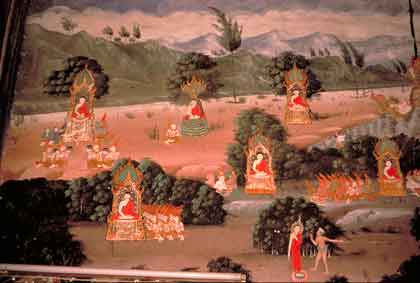
various Buddhas, the Thai version
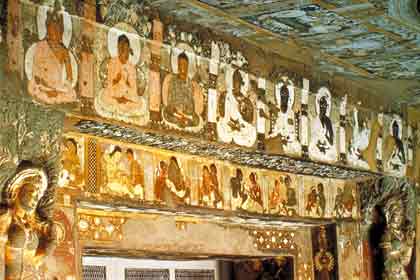
Phussa, Vipassi, Sikhi, Vessabhu, Kakusandha, Konagamana, Kassapa, and Gotama, Ajanta
Literally, the ‘Buddha’ means “one who has attained Enlightenment”. But such an interpretation, with every due respect to a linguist’s query, is not of much consequence to a reader or an audience interested in the stories of the Buddha or the Buddhas. This is because such interpretations can not expound the specific purport of the term used down the ages in a specific context. As ‘the meaning of the word lies in its use’, we must, therefore, try to explore the original meaning of the term as is specifically and contextually used in the Buddhist corpus for its definite connotative comprehension.
The Pali commentaries mention that there are four categories of the Buddha. The first is designative to the Sammasambuddhas or Sabbannu Buddhas (the Omniscient Buddhas). A Sabbannu Buddha is endowed with the ten powers (bala-s) and has the mission to proclaim the saving truth to all beings for their Nibbana (Deliverence). He is therefore called the ‘Sattharo’ (‘Teacher’ or ‘Master’) by way of the above characteristic. Further, because a Buddha plays the leading role of a pre-eminent person he is styled as the ‘Bhagava’ (‘Lord’). He is compared with the Universal Monarch (Raja Chakkavatti); and a lion (siha). He is called a ‘physician’ (‘bhisakko’) because he diagnoses the cause of suffering and prescribes the remedy; a ‘Kinsman of the Sun’ (‘Adiccha-Bandhu’) as he dissipates the darkness of ignorance; a ‘Buddha Vira’ as he gives shelter to all;an ‘Anuttara’, as he excels all; a “Brahmana” (though born in a Khattiya/Chatriya family) because he carries on the sacred tradition and excels in wisdom; self-control; and virtue. In short, a “Buddha is superior to all other beings – human or divine – by his knowledge of the truth”.
The second category of the Buddha is that of the Paccheka Buddha, which is designative of the Enlightened ones but not bound by the pledge to preach the Way of Deliverence to the world.
The third category of the Buddhas is referent to the Chatusaccha Buddha, who has destroyed the mental defilements or asavas. Finally, we also come across the category of the Bahussuta Buddha designating a learned person.
Nonetheless, the use of the ‘Buddha’ in the Pali literature is generally restricted to Sabbannu or Omniscient Buddha. Since Gotama was a Sabbannu Buddha he, too, is embellished with the epithet of the Buddha; and bears all other epithets applicable to any other Buddha.
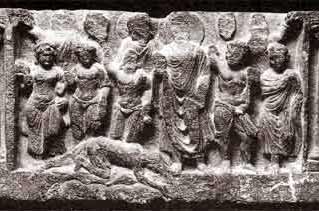

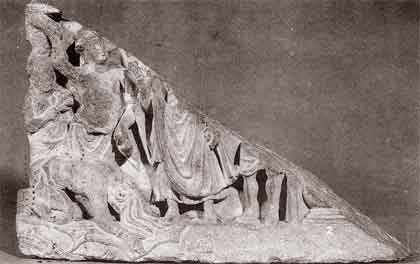

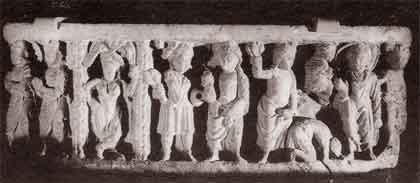
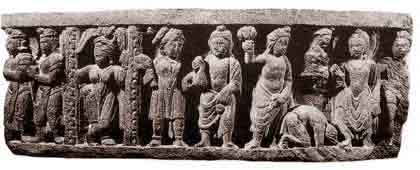

Sumedha’s abhinihara-karana or mulanidhana before the Dipankara Buddha,
who was the first Buddha. Sumedha later became Gotama Buddha
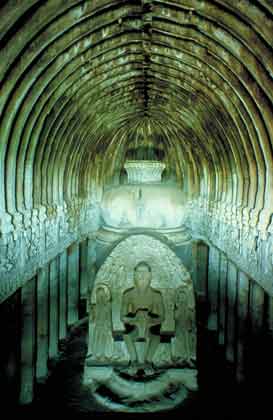
Gotama Buddha
The Introductory chapter of the Jataka Atthakatha presents a list of the twenty-five Buddhas (excluding the Future Buddha: Metteya), which is as follows:
- Dipankara
- Kondanna
- Mangala
- Sumana
- Revata
- Sobhita
- Anomadassi
- Paduma
- Narada
- Paduma Uttara
- Sumedha
- Sujata
- Piyadassi
- Atthadassi
- Dhammadassi
- Siddhattha
- Tissa
- Phussa
- Vipassi
- Sikhi
- Vessabhu
- Kakusandha
- Konagamana
- Kassapa
- Gotama
Sometimes, the tradition also identifies three additional Buddhas, who were born before Dipankara. The names of those Buddhas are Tanhankara, Medhankara and Sarankara.
The Buddhavamsa gives the particulars of each of the Buddhas with the details on their first sermons; aura of their bodies; and the description as to which Bodhisatta became which Buddha and so on. (See Buddhavamsa Atthakatha for details).
The Lalitavistara gives a list of fifty-four Buddhas; and the Mahavastu tenders a list of over one hundred Buddhas.
The Chakkavatti Sihanada Sutta of the Digha Nikaya gives the particulars of Metteya (Sanskrit: Maitreya) Buddha or the Future Buddha. Further, the Anagatavamsa gives a comprehensive account of the Future Buddha. And some Singhalese commentaries, go farther to tender a list of nine Future Buddhas on top of Metteya. They are Uttama, Rama, Pasendi Kosala, Abhibhu, Dighasoni, Sankaccha, Subha, Todeya and Nalagiri Palaleyya.
Common Facts about the Buddha
Thirty facts are common to all the Buddhas. For example, he is conscious of his conception in his last birth as a Bodhisatta. Further, he is seated cross-legged in the womb of his mother. His mother delivers him in standing position. The birth takes place in a forest. When born, he immediately takes seven steps; and roars like a lion. His body bears the thirty-two marks in addition to other features common to all the Buddhas. There are thirty-two specifically visible marks on the body of the Buddha, which are, for example, the signs of the wheels with spokes on his soles; projected heels; long digits; soft hands and feet; straight fingers and toes; shell-like round ankles; antelope-like legs and the length of the hands to touch the knee without bending; smooth golden hued stainless skin; black eyes; lion-like chaste; long tongue; forty-teeth and so on. (See Buddhavamsa Atthakatha 248; Lakkhana Sutta, Digha Nikaya; Mahapurisa Sutta, Samyutta Nikaya; Vassakara Sutta Anguttara Nikaya; and Milinda Panha 236).
There are, however, eight particular characteristics, which differentiate one Buddha from the other. These are the height of his body; his social rank; the area of his aura; the conveyance used to renounce the worldly life; the tree under which he attains Enlightenment; the size of his seat under the Bodhi tree (pallanka); the length of his austerities; and his longevity.
A Buddha is born only in our cosmic system (Chakkavala) out of the ten thousand similar systems, which have the property to sustain life (Jati-khetta). It may be noted that a Buddha is to be born only in the Jambudipa (or the Indian subcontinent).
Furthermore, one Buddha appears at one time only. Sometimes, more than one Buddha may be born in one aeon (kappa). The aeon or kappa having only one Buddha born is called ‘Sarakakappa’. When two Buddhas are born in an aeon the Kappa is called ‘Mandakappa’. When three are born in an aeon the Kappa is called ‘Varakappa’. When four are born in an aeon the ‘Kappa’ is called ‘Saramandakappa’; and when five Buddhas are born in an aeon, which is an extremely rare phenomenon, the Kappa is called ‘Bhaddakappa’.
Further, no Buddha is born until the order or the teaching of the previous Buddha completely vanishes from the earth. According to one tradition the teachings of Gotama Buddha shall vanish after five thousand years.
Bodhisatta (Pali Tradition)
A reader will note that the protagonist of every Jataka story is the Bodhisatta. A Bodhisatta is one who aspires to attain the bodhi or Enlightenment; and makes a proclamation of his solemn resolve to become a Buddha for the welfare and liberation of all creatures before each of the Buddhas, who he meets. The declaration of such a pledge by a Bodhisatta before an existing Buddha is called abhinihara-karana or mulanidhana. In the case of Gotama Buddha, his abhinihara was made before Dipankara Buddha when his name was Sumedha. Further, the existing Buddha, i.e., Dipankara in the above case approved of his abhinihara by the declaration (vyakarana) that ‘the Bodhisatta shall become a Buddha’ [owing to his suitability]. Thus, Gotama received his first vyakarana from Dipankara Buddha when he was Sumedha. He received his second vyakarana from Kondanna when he was born as Chakkavatti Bodhisatta. The third from Mangala when he was Suruchi.; the fourth from Sumana when he was Atula; the fifth from Revata when he was Atideva; the sixth from Anomadassi when he was a yakkha chief; the seventh from Paduma when he was a lion; the eighth from Narada when he was a sage; the ninth from Padumuttara when he was Jatila; the tenth from Sumedha when he was Uttara; the eleventh from Sujata when he was an emperor; the twelfth from Piyadassi when he was Kassapa; the thirteenth from Atthadassi when he was Susima; the fourteenth from Dhammadassi when he was Sakka (Indra); the fifteenth from Siddhattha when he was Mangala; the sixteenth from Tissa when he was Sujata; the seventeenth from Phussa when he was Vititavi; the eighteen from Vipassi when he was Atula; the nineteenth from Sikhi when he was Arindama; the twentieth from Vessabhu when he was Sudassana; the twenty-first from Kakusandha when he was Khema; the twenty-second from Konagamana when he was Pabbata; and the twenty-third from Kassapa when he was Jotipala. (See Buddhavamsa and Jatakatthakatha for details).
After receiving the Vyakarana a Bodhisatta seeks to develop the unique qualifications of the Buddhahood (Buddhakarakadhamma) and strives for ten perfections (parami), namely, dana (charity), sila (right-conduct), nekkhama (dispassionateness), panna (wisdom), viriya (steadfastness), khanti (forbearance), saccha (truthfulness), adhitthana (pledge), metta (loving compassion), and upekkha (non-attachability). The struggle for the ten perfections in various births of Sumedha Bodhisatta is rather the main theme of the Jataka stories, which is remarkably exemplified in the Ekaraja, Khantivadi, Chulla Sankhapala, Maha Janaka, Mahasutasoma, Mugapakkha, Lomahamsa, Sattubhattaka, Sasa, Sutasoma and Vessantara Jatakas. So, in other words each Jataka story is rather an exemplification of the Bodhisatta’s struggle for perfection for a parami.
Furthermore, a Bodhisatta has to develop four bhumis, namely, ussaha or viriya (zeal), ummagga or panna (wisdom), avatthana or adhitthana (resolution) and hitachariya or metta (compassion). Then he practices six ajjhasayas or the factors conducive to the maturing of the bodhi.
Various Births of the Bodhisatta
In the Jataka Stories the Bodhisatta has a variety of birth as he is born as an acrobat (Dubbaccha Jataka); an ascetic (in numerous births); a non-Buddhist ascetic (Lomahamsa Jataka); a barber (Illisa Jataka); a caravan leader (Kimpaccha and Mahavanijja Jatakas); a carpenter (Samuddavanijja Jataka); a conch-blower (Sankhadhamana Jataka); a chaplain (various births); councillor (Kacchapa; Kalayamutthi; Valodaka. Jatakas etc); a courtier (Bahayi Jataka etc.); a dice player (Litta Jataka); a drummer (Bherivada Jataka); an elephant-trainer (Sangamavachara Jataka); a farmer (Suvanna-kakkata; Sihachamma Jatakas etc); a forester (Khurappa Jataka); a gardener (Kuddalaka Jataka); a gold-smith (Kunala Jataka); a hawker (Seriva Jataka); a tumbler (Ucchitthabhatta Jataka); a horse-dealer (Kundakakucchisindhava Jataka); a house-holder (Gahapati; Jagara Jatakas etc); a judge (Kutavanijja Jataka etc.); a mariner (Supparaka Jataka); a minister (Vidhurapandita Jataka etc.); a musician (Guttila Jataka); a physician (Kama and Visvanta Jatakas); a potter (Kacchapa and Kumbhakara Jatakas); a robber (Kanavera and Sotapatta Jatakas); a smith (Suchi Jataka); a stone-cutter (Babbu Jataka); a teacher (several births viz., Anabhirati; Durajana and Losaka Jatakas etc.); a treasurer (Chullaka; Sankha Jatakas etc.); a valuer (Tandulanali Jataka) in addition to a king like Buddhadatta; or a member of a noble family as Dhammapala. He is also born as a menial or chandala, e.g., Chitta and Matanga.
Further, he is born as the lord of the heavenly world as Sakka or Indra, (e.g., Kamanita; Mahapanada; Kelisila and Vaka Jatakas); as a deva as Dhamma and Bhaddasala (and in Kakkaru; Kamavilapa; and Mittavinda Jatakas); as a Brahma of the Abbhasara world (Chandabha and Janasodhana Jatakas); as Maha Brahma (Parosahassa and Mahanarada Kassapa Jatakas); an air sprite (Puppharatta Jataka); a mountain sprite (Kaka and Smudda Jatakas); a tree spirit (Ayachitta and Vaka etc. Jatakas); a forest sprite (Kandina and Guthapaka Jatakas).
Among the animals he is born as a buffalo (Mahisa Jataka); a bull (as Ayyakalaka; Nandivisala; Mahalohita; Sarambha); a rooster (Kukkuta Jatakas No.s 383 & 448); a crow as a Varaka, Supatta (and in Kaka Jataka); as an elephant (Chaddanta and Silava Jatakas); a fish as Mitachinti; a frog (Haritimata Jataka); a garuda or eagle (Sussondi Jataka); a goose (Neru Jataka); a hare (Sasa Jataka); a horse as Vataggasindhava ( and in Ajanna & Bhogajanna Jatakas); an iguana (Godh Jataka); a jackal (Sigala Jataka); a Kinnara as Chanda; a wild duck (Naccha Jataka); a monkey (as Nandiya and in Kapi, Mahakapi; Nalapana, Sumsumara, Jatakas); a lion (Gula; Sigala Jatakas etc.); a parrot as Radha, Potthapada, Pupphaka and Jambuka etc.); a peacock (Mora; Baveru; Mahamora Jatakas etc.); a pig (Mahatundila Jataka); a pigeon (Kapota; Romaka; Lola; Kaka no. 395 Jatakas); a quail (Vattaka and Sammodamana Jatakas); a cat (Aggika and Bilara Jatakas); a snake (Champeyya; Sankhapala; Bhuridatta; and Mahabhaddara Jatakas); a vulture (three Gijjha Jatakas no.s 164; 399 & 427); and a wood-pecker (Javasakuna & Khadiravaniya Jatakas).
Treatment of the Pali Jataka Stories
The treatment of the Jataka Stories may be analysed in five stages:
- Contextuality of the story (Pacchuppanna-vatthu) or the background and the occasion which necessitated the Buddha to narrate the story;
- Narrative of the past (Atita-Vatthu), which depicts the narrative of the previous life of the Bodhsatta;
- Recitation of the original Jataka verse (Gatha) to accentuate and impart the moral of the story;
- Explanation of the verse (Veyyakarana);
- Identification of the characters of the stories at the time of the narrator (i.e., the Buddha).
Jatakas in the Sanskrit Language
The Sanskrit version of the Tipitaka is not preserved in original in its entirety. Yet, the Mahavastu Avadana, often considered to be the part of the Sanskrit version of the Vinaya Pitaka, records thirty-nine Jatakas like Trishkuniyaka Jataka, Rishava Jataka, Manjari Jataka, Godha Jataka, Shayama Jataka and so on. Furthermore, some of these Jatakas have dual versions, viz., one in prose and the other in verse, e.g., Shyama Jataka and Kusha Jataka. A Jataka may be called an Avadana (narrative of the noble deeds of a noble being) as it records the noble deeds of the Bodhisattva.
The other important source of the Sanskrit version of the Jatakas is the Jatakamala, written by Aryashura in the fourth century A.D. This work contains thirty-four Jataka stories. The style of Aryashura is classical and some critics have found his works like the Vishvantara Jataka comparable with any work of Kalidasa or Bhasa
Buddha & Bodhisattva (the Mahayana View)
Each of the Mahayana schools, namely, Paramita, Yoga and Anuttara has its unique concept of the Buddhas and the Bodhisattvas (Pali: Bodhisatta). Yet, for all practical purpose it may be said that they believe in the Adi Buddha. (ëAdií means ìhaving no beginning and no endî). The union of the Adi Buddha and the Adi Prajna (or Wisdom having no beginning and no end) accounts for the hierarchies of the Buddhist deities.
Further, it is believed that there are five Dhyani (Meditating) Buddhas involved in deep meditation. A Dhyani Buddha is one who does not take part in the affairs of the world The five Dhyani Buddhas are Vairochana, Aksobhya, Ratnasambhava, Amitabha and Amoghasiddhi, who also refer to the families (kula) of the Anuttara Tantra. Vajradhara is computed as the sixth family, which is believed to be of the highest class. It may be noted that varied Tantras of various families and kriyas are existent. Eventually, specific Tantras are meant for the individual families for specific evocations (sadhana) and rites (vidhi). Further, each of the family has a kulesha (or lord of the family, i.e., Progenitor); and a progeny (kulika). In the Anutttara system of Tantra Vairochana is the Progenitor (Kulesha) and Victor (Jina). The deities and their transformations created by his seal (mudra) are his progeny.
The five families of the Yoga Tantra are Tathagata, Ratna, Padma, Karma and Vajra. The family of the Tathagata is the highest.
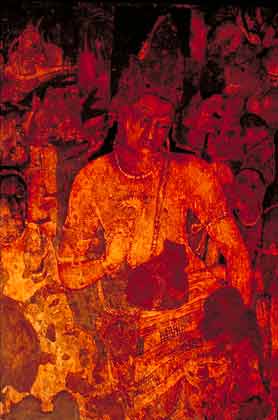
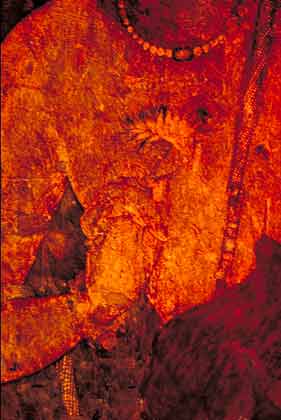
Padmapani Bodhisatta (Avalokiteshvara)
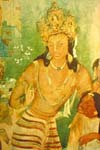
Vajrapani, who became Kanakamuni Buddha
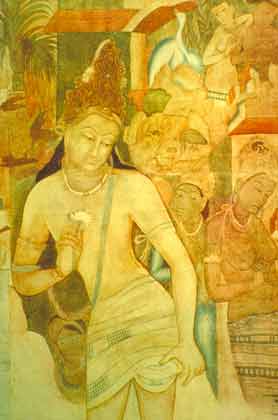
Bodhisattva Avalokiteshvara (also called Padmapani). He took birth in the human (Manushi) form as Gotama Buddha in the present aeon.

Bodhisattva Vishvapani, who is yet to be born as Metteya Buddha in the human form.
Coming back to the five Dhyani Buddhas – who do not take part in the affairs of the world – are seldom portrayed individually. They may appear on the tiara of the male and the female divinities emanated from them or round their heads in a group of five. All the five Dhyani Buddhas are shown seated in Vajrasana, legs being closely crossed and locked and the soles visible.
Mudras of each of the Dhyani Buddha

Buddha in the dhammacakka-pavattana mudra
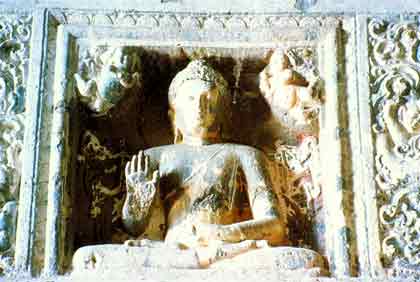
The Buddha in abhaya mudra
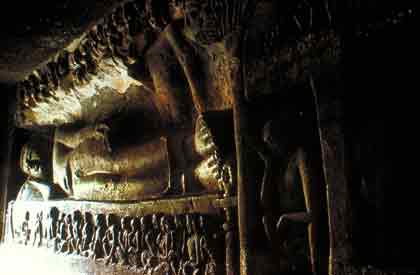
The Buddha in the parinibbana mudra
| Dhyani Buddha | Corresponding mudraa (mudra) or posture |
| Vairochana | Uttarabodhi and Dharmachakra Mudras. In the first posture the index finger and the thumb of each hand is joined and held close to the breast. In the second case the thumb and the index finger of the right hand are placed in contact with the left hand in a gesture as if the right hand will turn a wheel by a twist. |
| Aksobhya | Bhumisparsha (earth or seat-touching) Mudra. The left palm rests on the lap; and the right touches the earth. Note: the left palm is visible but the right one does not face the beholder. |
| Ratnasambhava | Varada (or boon-bestowing) Mudra. Same as the above but the palm of the right hand is in front. |
| Amitabha | Samahita (or absorbed-in-meditation) Mudra. One hand rests over the other on the lap with palm upwards. |
| Amoghasiddhi | Abhaya (or protection giving) Mudra. Left hand is placed on the lap; Right hand raised to the breast; palm front; and fingers upwards. |
Each of the five Dhyani Buddhas has his unique distinctive mark and characteristics. For example, Vairochana is white; Akshobhya is blue; Ratnasambhava is yellow; Amitabha is red; and Amoghasiddhi is green. Further, each represents a direction and has a representative element and a sense-corresponding object; and an espouse as shown in the diagram below:
| Dhyani Buddha | Quarters | Colour | Elements | sense objects | consort |
| Vairochana | central | white | ether | sound | Vajradhatvishvarii |
| Aksobhya | east | blue | air | tangible | Lochanaa |
| Ratnasambhava | south | yellow | fire | visibile | Maamakii |
| Amitabha | west | red | water | gustatory | Paandaraa |
| Amoghasiddhi | north | green | earth | olfactory | Taaraa |
The female deities classified with Vairochana are White Tara, Ushnishavijayaa, Jaangulii Tara, and Marichi; with Akshobhya are Blue Tara and Ekajata; with Ratnasambhava are Yellow Tara, Vasudhara and Vajra Tara; with Amitabha are Red Tara or Kurukulla, Sitatapatra, and Bhrikuti; and with Amoghasiddhi are Green Tara and Parnashvarii.
Furthermore, each of the five Dhyani Buddhas has a corresponding Dhyani Bodhisattva; and a corresponding Buddha in a human form (Manushi Buddha) as shown in the diagram given below:
| Dhyani Buddha | Corresponding Bodhisattva in an Aeon | Corresponding Buddha in human Form |
| Vairochana | Samanta Bhadra | Krakuchandra |
| Aksobhya | Vajrapani | Kanakamuni |
| Ratnasambhava | Ratnapani | Kashyapa |
| Amitabha | Avalokiteshvara or Padmapani | Gautama |
| Amoghasiddhi | Vishvapani | Maitreya |
Sometimes the Bodhisattvas are represented in a group of eight in place of the five by the elision of Ratnapani and Vishvapani and inclusion of Aakaashgarbha, Ksitigarbha, Sarva-nivarana-vishkambhin, Manjushri and Maitreya. As Maitreya is already projected in human form the most important among the four is Manjushri, who represents the sword of wisdom.

Manjushri. The four different manifestations are projected on the four corners.
(Courtesy: Sakyamuni: An Exhibition of Rare Thankas Central Institute of Buddhist Studies Choglamsar Leh; p.23)
[i] The Vinaya Pitaka, deals with the Buddhist codes and conduct and may be regarded as the Corpus of the Discipline. It supposedly records the recitations made by the thera Upali in the council. The latter two pitakas, collectively called the ëDhammaí (or the doctrine), are the collection of the recitations given by the thera Ananda (the closest disciple of the Buddha) in the same council. The recitations of the aforementioned two monks, as a matter of fact, are the answers by way of the explanations and elucidations to the questions posed by the President of the council – Mahathera Mahakassapa.
(Upali thermam Vinaye, sesa-dhamme Asesake
Ananda-thream akarum sabbe thera dhurandhara
Mahathero sakattanam, vinayam pucchitum sayam
Sammaní Upali-thero ca, visajjetum tam eva tu . Mahavamsa 30-31). It may be added that the Mahavamsa, the Singhalese chronicle, authentically lays the foundation of the construction of the ancient history of modern India which corroborated to the identification of Ashoka – whose inscriptions are still extant in several pockets of Asia.
The Abhidhamma Pitaka deals with the philosophy and psychology of the Theravada school of Buddhism. The ìtheravadaî, however, refers to that school of Buddhism which, supposedly ìadhere to the most original and purest form of the Buddhist teachingsî, advocated by those theras (monks) who obtained the erudition directly through the Master. Further, they used the bhasa Magadhika or the mula bhasa (the original language)[i] to record the original text or the pariyaya, (the text of the canons). The term pariyaya, however, when abbreviated became ëparií or ëpalií; and in course of time was applied to denote the language of the entire gamut of the canons; and the exegeses and other compositions on those texts having the same language.
Aggam bahusuttadinam, kosarakkham mahesino
Sammannitvana attanam thero dhammam apucchi so
Tatha sammanniyattanam dhammasanagato sayam
Visajjesi tam Ananda-thero dhammí asesato. (Mahavamsa 34-35)
[ii] A Sinhalese chronicle and a principal source for the construction of the history of ancient India. This chronicle presents the history of India, particularly of Chanakya, Chandra Gupta Maurya and Ashoka the Great and so on. It may be pointed out that without the existence of these chronicles, we would not have known the history of ancient India, particularly down to the Mauryan Age
[iii] Thero anekasankhamha bhikkhusangha visarade
chalí abhinne Tepitake pabhinna-patisambhide. (Ibid. 275)
[ Content List ]




